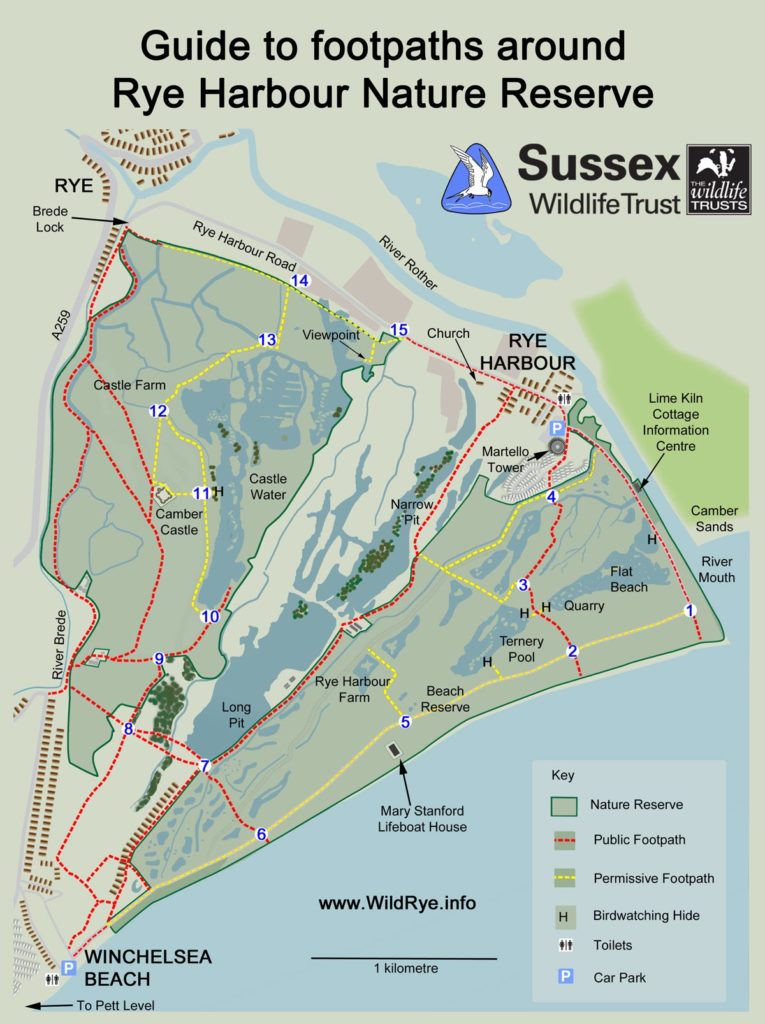Winchelsea is home to an assortment of animals, wildlife and various types of migratory birds. There are various organisations that take care of the flora and fauna of the region and allow locals and tourists to come and enjoy the fruits of this natural habitat. The Rye Harbour Nature Reserve is the largest organization operation on the Rye region of Winchelsea. Natural trust rangers also operate in the area and work with wildlife to conserve their natural habitat.
Rye Harbour Nature Reserve
Rye Harbour is one of Rye’s hidden treasures. It is a gigantic patch of land that has all sorts of wildlife, plants, bird etc. You can just have a stroll beside the sea or have a picnic under the tree.
The influence of the sea has been greatly reduced during the last hundred years by man-made sea defences that curtail the foces of nature. In addition to this, the naturally high-water table has been lowered by a drainage system that is emptying into the rivers. These two factors have enabled the traditional agriculture of grazing with some arable land to add to that. Just within the Nature Reserve there are many natural habitats that have resulted from a variety of soils; a gradient of salinity, and also varying degrees and levels of exposure to wind and flooding by the sea. Consequently, there is a huge and wide variety of species with 3,540 recorded so far. More than 200 of them are considered to be rare and endangered in Britain.
The different types of wildlife that can be found in the Rye Harbour Nature Reserve are:

Plants
 The best time to come and pay a visit to the reserve is Late May or June. The beach is completely transformed by a colourful variety of flowers. This includes the Sea Kale, the bright Yellow Horned Poppy, the stark colours of the Sea kale and carpets of lush Sea pea to boot.
The best time to come and pay a visit to the reserve is Late May or June. The beach is completely transformed by a colourful variety of flowers. This includes the Sea Kale, the bright Yellow Horned Poppy, the stark colours of the Sea kale and carpets of lush Sea pea to boot.
You will also find a large amount of tidal saltmarsh vegetation along the edge of the river. If you go towards Camber Castle, you will chance upon some special and unique flora and fauna. There have 456 species of flowering plants that have been recorded on this wonderful reserve.
Invertebrates
A good variety of plant life is usually accompanied by an equal selection of animal life. This reserve can be described as a priceless gem and a location of national importance. Scientists has discovered 2321 species of different animals in this reserve alone! Some famous one is the Medicinal Leech and the Spangled Button Beetle.
Vertebrates
There are many vertebrates that could interest the animal lover on the reserve. The Brown hare is caught walking on the beach quite often. The Marsh frog croaks away to glory during the summer.
The Marsh Frog can be heard croaking loudly all summer and is one of the most talked about large animals on the reserve. Another prominent animal is the Brown Hare, and is regularly seen on the beach throughout the year. As night falls, the Reserve is the domain of Badgers, Foxes and Bats.

Birds

The bird life would be Rye Harbour’s most well-known feature. The breeding colonies that exist here are some of the best in the world. There various famous birds like the Sandwich Tern, the exotic Little Tern and the more easily found Common Ternand. There been many exciting developments in terms of the bird life in the reserve. The population of a lot of these birds has increased which is wonderful news to us all. The Lapwing, the Wheater, the Ringer Plover, the Oystercatcher, and the Redshank have all increased in number and their breeding success has gone up. The reserve has a large group of more than 2709 species of birds that have been recorded on it’s premises. Another feature of Rye harbour is the migratory birds that stay here. It is a wonderful place to observe bird migration.
Conservation Work By The National Trust
It took more than a decade of conservation work that has resulted with the first-ever sighting of water voles at Winchelsea. Once a common sight, they have disappeared from almost 90% of rivers and streams. National Trust Area Ranger Andrew Dyer tell us more about Britain’s rarest rodent.
‘For many years we have surveyed the ditches around Winchelsea and spotted potential signs of water voles.
Famous as the inspiration for Ratty - hero of Kenneth Grahame’s Wind in the Willows – the charismatic water dwellers are Britain’s fastest-declining mammal.
The geography and landscape of Winchelsea is highly suited to water voles. The slow-moving water is always kept clean and is rarely disturbed by people. Vegetation is managed carefully, and waterside plants in particular are taken care of, to provide the water voles a healthy supply of food. Natural features such as steep banks are ideal for burrows whilst mink, a major predator and detrimental to their growth, are low in numbers and help the water vole thrive in this tiny town.
With all these amazing creatures to see in Winchelsea, what are you waiting for? Book your tickets and come see for yourself!

